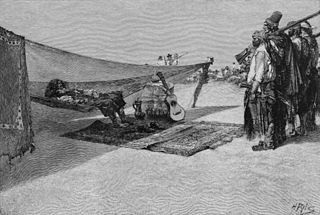
Buccaneers were a kind of privateer or free sailor peculiar to the Caribbean Sea during the 17th and 18th centuries.

Alexandre Olivier Exquemelin was a French, Dutch or Flemish writer best known as the author of one of the most important sourcebooks of 17th-century piracy, first published in Dutch as De Americaensche Zee-Roovers, in Amsterdam, by Jan ten Hoorn, in 1678.

The Golden Age of Piracy is a common designation given to usually one or more outbursts of piracy in the maritime history of the early modern period. In its broadest accepted definition, the Golden Age of Piracy spans the 1650s to the late 1720s and covers three separate outbursts of piracy:
- The buccaneering period of approximately 1650 to 1680, characterized by Anglo-French seamen based on Jamaica and Tortuga attacking Spanish colonies and shipping in the Caribbean and eastern Pacific
- The Pirate Round of the 1690s, associated with long-distance voyages from the Americas to rob Muslim and East India Company targets in the Indian Ocean and Red Sea
- The post-Spanish Succession period extending from 1716 to 1726, when Anglo-American sailors and privateers, left unemployed by the end of the War of the Spanish Succession, turned en masse to piracy in the Caribbean, the North American eastern seaboard, the West African coast, and the Indian Ocean

Michel de Grammont was a French pirate. He was born in Paris, Kingdom of France and was lost at sea in the north-east Caribbean, April 1686. His pirate career lasted from around 1670 to 1686 during which he commanded the flagship Hardi. He primarily attacked Spanish holdings in Maracaibo, Gibraltar, Trujillo, La Guaira, Puerto Cabello, Cumana and Veracruz.
Daniel Johnson (1629–1675) was an English buccaneer who, serving under buccaneers as Moyse Van Vin and Pierre le Picard, sailed against the Spanish during the late 17th century becoming known among the Spanish as "Johnson the Terror". There is little record of his career aside from a single body of work, Appleton's Cyclopædia of American Biography (1887), suggesting he may be a fictional character.

The Brethren or Brethren of the Coast were a loose coalition of pirates and privateers commonly known as buccaneers and active in the seventeenth and eighteenth centuries in the Atlantic Ocean, Caribbean Sea and Gulf of Mexico.
Anne Dieu-Le-Veut also called Marie-Anne or Marianne was a French pirate. Alongside Jacquotte Delahaye, she was one of very few female buccaneers. While Delahaye was likely fictional, Dieu-le-Veut was real; however, many of her exploits are inventions of later writers.
See also: list of 'years of Piracy'.

Daniel Montbars (1645–1707?), better known as Montbars the Exterminator, was a 17th-century French buccaneer. For several years, he was known as one of the most violent buccaneers active against the Spanish during the mid-17th century. His reputation as a fierce enemy of the Spanish Empire was matched only by l'Ollonais and Roche Braziliano.

Edward Mansvelt or Mansfield was a 17th-century Dutch corsair and buccaneer who, at one time, was acknowledged as an informal chieftain of the "Brethren of the Coast". He was the first to organise large scale raids against Spanish settlements, tactics which would be utilised to attack Spanish strongholds by later buccaneers in future years, and held considerable influence in Tortuga and Port Royal. He was widely considered one of the finest buccaneers of his day and, following his death, his position was assumed by his protégé and vice-admiral, Henry Morgan.

Moïse Vauquelin or Moses Vanclein was a 17th-century French buccaneer. During his four-year career as a privateer, he served as an officer under l'Ollonais and formed a brief partnership with Pierre Le Picard. He and Philippe Bequel later co-wrote a book detailing their explorations of the Honduran and Yucatán coastline.

Pierre le Picard (1624–1679?) was a 17th-century French buccaneer. He was both an officer to l'Olonnais as well as Sir Henry Morgan, most notably taking part in his raids at Maracaibo and Panama, and may have been one of the first buccaneers to raid shipping on both the Caribbean and Pacific coasts.
John Nutt was a 17th-century English pirate. He was one of the more notorious brigands of his time raiding the coast of southern Canada and western England for over three years before his capture by Sir John Eliot in 1623. His arrest and conviction caused a scandal in the English court, after Nutt paid Eliot £500 in exchange for a pardon, and was eventually released by Secretary of State George Calvert.
See also: 1705 in piracy, 1707 in piracy and the list of 'years of Piracy'.

The Capture of Fort Rocher took place on 9 February 1654, during the Franco-Spanish War (1635–1659). Equipped with one siege battery, a Spanish expedition of 700 troops attacked the buccaneer stronghold of Tortuga, capturing the Fort de Rocher and 500 prisoners including 330 buccaneers and goods valued at approximately 160,000 pieces-of-eight. The Spanish burned the colony to the ground and slaughtered its inhabitants, leaving behind a fort manned by 150 soldiers. They possessed the island for about eighteen months, but on the approach of the expedition under Penn and Venerables were ordered by the Conde de Peñalva, Governor of Santo Domingo, to demolish the fortifications, bury the artillery and other arms, and retire to his aid in Hispaniola.
James Browne was a Scottish pirate and privateer active in the Caribbean. He is best known for his hasty execution and the effects it had on colonial Jamaican government.












